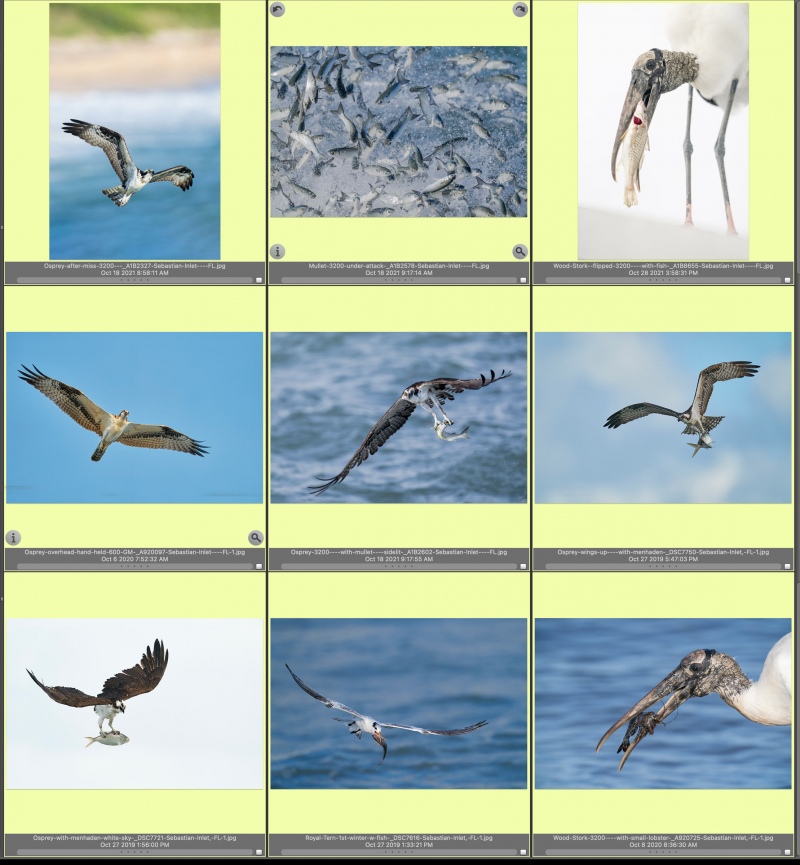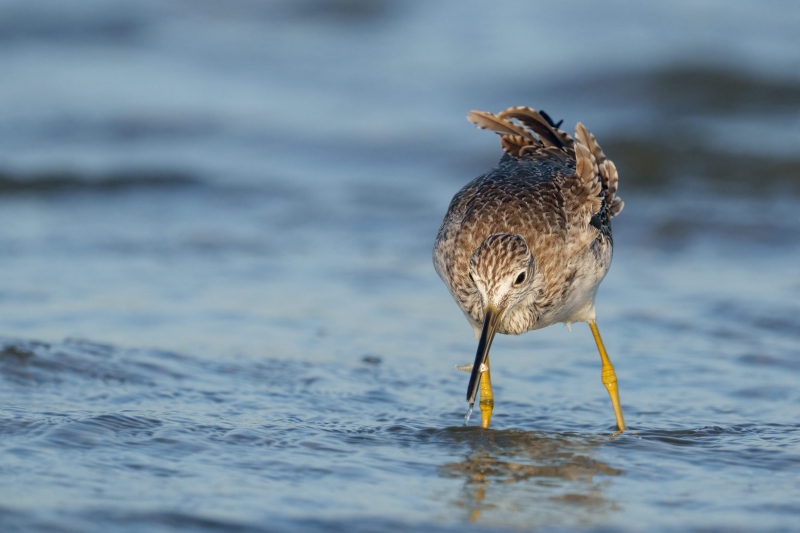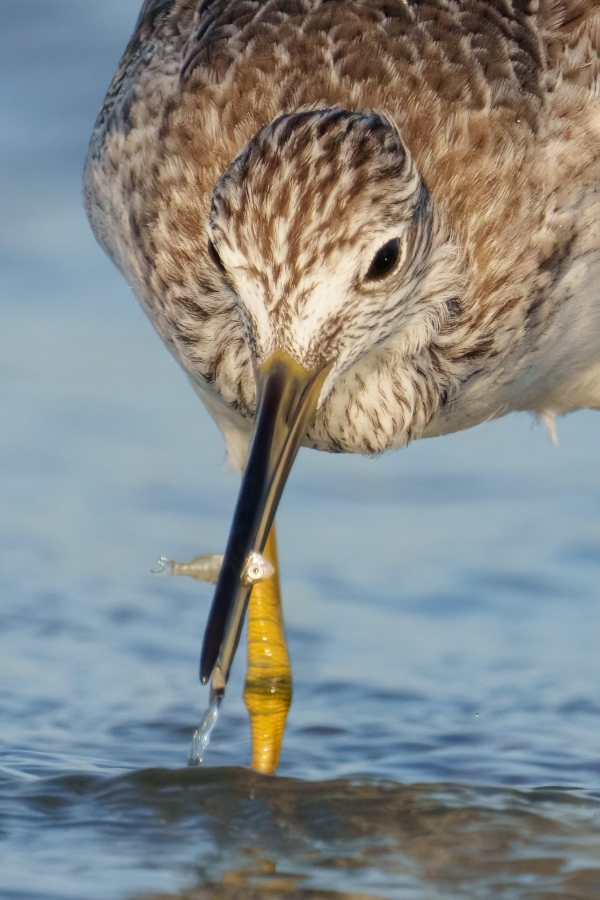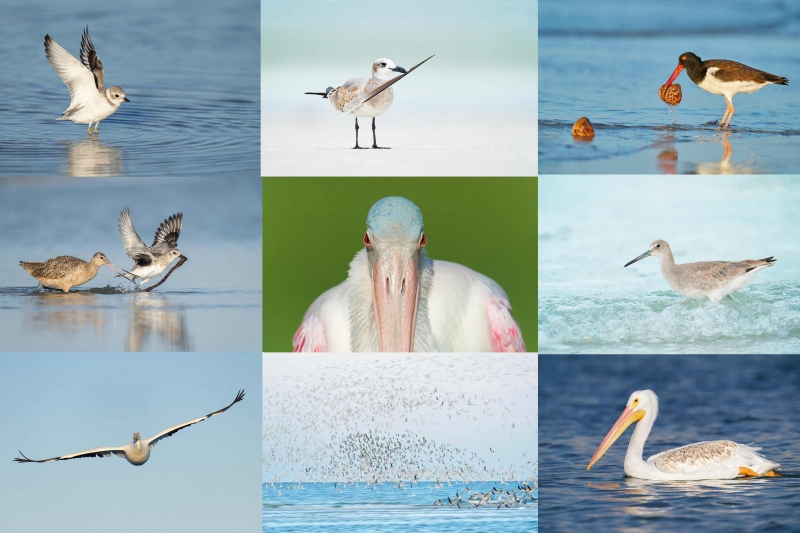Canon EF 400mm F/5.6L USM Lens (the “toy” lens)
Marty Paige is offering a well-used Canon EF 400mm F/5.6L USM lens in good condition for a silly low $399.00. The front glass is clean and the lens functions perfectly. The sale includes the front and rear lens caps, the lens case with strap, the original product box, the user guide, and insured ground shipping via major courier to lower-48 US addresses. Photos are available upon request. Your item will not ship until your check clears unless other arrangements are made.
Please contact Marty via e-mail at e-mail or by phone at 1-423-458-8990 (Eastern time zone).
The old 400mm f/5.6 L lens was my first Canon autofocus lens. It was light and sharp and still is. It quickly become my favorite flight lens and I referred to it often as my “toy” lens. I pretty much put it on the map for bird photography. With an adapter, it is a great starter lens for anyone wishing to get into bird photography without breaking the bank. There is a used copy of this lens at B&H for $809.95. artie
|
|
|
Clockwise from the upper left back around to center: Osprey gaining altitude after missed strike; school of mullet under attack from below; Wood Stork with Southern Whiting; Osprey with Menhaden; Wood Stork with small lobster; Royal Tern with large baitfish; Osprey with Menhaden; juvenile Osprey directly overhead “t-shot”; Osprey taking flight with freshly caught Mullet. |
Sebastian Inlet In-the-Field Sessions
Join me for 3 hours of morning In-the-Field Instruction at Sebastian Inlet for only $300.00/session. The main target will be Ospreys fishing for a variety of migrating saltwater fish that visit the inlet each fall. Back-up subjects include fishing gulls, terns, and Brown Pelicans, Wood Stork, a variety of herons and egrets, sunrise cloud-scapes, and the occasional sea turtle or manatee.
November Dates: 6-10, 2023.
Please get in touch via e-mail to book one or more sessions.
My Call I
Speaking of Ospreys, my very favorite Osprey image in the “Lots on Exposure. Hovering Versus Kiting. Sebastian Inlet Spectacular on Friday. Handholding versus Tripod for 840mm Flight Photography. And More On Flight Poses” blog post here was Image #2, Osprey beginning dive because of the spectacular flight pose, the spread tail, and the dark blue-gray sky. That said, it barely edged out Image #4, Osprey flying off with Menhaden (mossbunker) for the perfect fish, the wings raised flight pose, the sharpness, the sweet early light, and the blue water.
My Call II
In the “What was Chris Doing Right and Wrong” blog post here, those who commented were pretty much on target.
The best thing that Chris was doing was getting low for an intimate perspective. And getting wet 🙂
The worst thing he was doing IMHO was supporting the lens from below by the foot. By first rotating the lens foot to the top of the lens and then placing his left hand farther out on the lens barrel, he would be better able to hold the lens steady. Holding a lens by the foot remind is too much of a teeter-totter set-up for my tastes.
The second thing he was doing wrong was using Canon gear rather than Sony (he said somewhat tongue-in-cheek). Remember that good photographers make good images with whatever gear they have in their hands. It’s just easier for me with Sony.
What’s Up?
Though conditions have been on the tough side I have been making great images every session. Wednesday morning featured clear skies and a north by slightly west wind — death for most bird photography. Keep reading below to see how I succeeded where everyone else pretty much failed.
I was thrilled to learn on Tuesday that Stan Gorlitsky sold his Nikon NIKKOR Z 800mm f/6.3 VR S lens in mint condition right after it was listed on the Used Gear Page for a very low $5400.00 (was $5,496.95). As is always the plan, both the seller and the buyer were happy.
Today is Thursday 2 November 2023. Can you believe that it is already November? I will be headed to the park early again hoping that there is, as predicted, some east in the north wind. Wherever you are an whatever you are doing, I hope that you too have a great day.
Please remember to use the B&H and Amazon links that are found on most blog pages and to use the BIRDSASART discount code at checkout when purchasing your new gear from Bedfords to get 3% back on your credit card and enjoy free second-day air FedEx. Please, also, consider joining a BAA IPT. You will be amazed at how much you will learn!
You can find some great photo accessories (and necessities, like surf booties!) on Amazon by clicking on the Stuff tab on the orange/yellow menu bar above. On a related note, it would be extremely helpful if blog-folks who, like me, spend too much money on Amazon, would get in the habit of clicking on the Amazon logo link on the right side of each blog post when they shop online. As you might expect, doing so will not cost you a single penny, but would be appreciated tremendously by yours truly. And doing so works seamlessly with your Amazon Prime account.
If an item — a Delkin flash card, or a tripod head — for example, that is available from B&H and/or Bedfords, is also available in the BAA Online Store, it would be great, and greatly appreciated, if you would opt to purchase from us. We will match any price. Please remember also to use my B&H affiliate links or to earn 3% cash back at Bedfords by using the BIRDSASART discount code at checkout for your major gear purchases. Doing either often earns you free guides and/or discounts. And always earns my great appreciation.
B&H Simplified
To ensure that I get credit for your B&H purchases, you can always click here. The tracking is invisible but greatly appreciated. And, you can use your PayBoo card. You must use the website to order. B&H will reopen on Fri April 14. Thanking me for the past 4000 educational blog posts could not be any easier and will not cost you one penny. Please shoot me your B&H receipt for major purchases.
Bedfords Simplified
Click here to start your search. Choose standard shipping, and when you get to the payment page, enter BIRDSASART in the discount code box and hit apply. You will be upgraded to free second day air Fed-Ex and receive 3% cash back on your credit card once your stuff ships. Either is greatly appreciated by yours truly.
B&H
Many folks have written recently stating that they purchased a Sony a1 from B&H and would like their free membership in the Sony 1 Info and Updates Group, a $150.00 value. When I check my affiliate account, their orders have not been there. When I let them know that they get credit for B&H purchases only if they use one of the many B&H affiliate links on the blog or begin their searches with this link, they are always disappointed. If in doubt, please contact me via e-mail and request a BH link. I am always glad to help and to guide you to the right gear.
Bedfords Amazing BAA Discount Policy
Folks who have fallen in love with Bedfords can now use the BIRDSASART coupon code at checkout to enjoy a post-purchase, 3% off-statement credit (excluding taxes and shipping charges) on orders paid with a credit card. The 3% credit will be refunded to the card you used for your purchase. Be sure, also, to check the box for free shipping to enjoy free Second Day Air Fed-Ex. This offer does not apply to purchases of Classes, Gift Cards, prior purchases.
Visit the Bedfords website here, shoot Steve Elkins an e-mail, or text him on his cell phone at (479) 381-2592.
Important Note
As an Amazon Associate, I earn a small percentage when you purchase from Amazon after using any of the Amazon links on the blog (including the logo-link on the right side of each blog post page). My affiliate link works fine with Amazon Prime and using it will not cost you a single cent. Huge thanks, BTW 🙂


Gear Questions and Advice
Too many folks attending BAA IPTs and dozens of photographers whom I see in the field and on BPN, are — out of ignorance — using the wrong gear, especially when it comes to tripods and more especially, tripod heads. And the same is true in spades when ordering new camera bodies or lenses. My advice will often save you some serious money and may help you avoid making a seriously bad choice. Please know that I am always glad to answer your gear questions via e-mail. If you are desperate, you can try me on my cell at 863-221-2372. Please leave a message and shoot me a text if I do not pick up.
|
|
|
This image was created on 1 November 2023 at Fort DeSoto Park, south of St. Petersburg, FL. While crouching a bit, I used the hand held Sony FE 200-600mm f/5.6-6.3 G OSS lens with the Sony FE 1.4x Teleconverter (at 832mm) with The One, the Sony a1 Mirrorless Camera ISO 2000. Exposure determined via Zebras with ISO on the Thumb Wheel: RawDigger showed that the exposure was dead solid perfect: 1/3200 sec. at f/9 (wide open) in Manual mode. AWB at 8:33:28pm on a sunny morning. Tracking: Zone/AF-C with Bird Eye/Face Detection enabled performed perfectly. Be sure to click on the image to see a larger, sharper high-res version. Image #1: Greater Yellowlegs with tiny fish |
Not Something That You See Everyday!
I have seen a few shorebirds over the past 47 years. I cannot remember ever seeing a yellowlegs capture a fish; I did not see this tiny fish until I was culling the images in Photo Mechanic. Their normal diet consists of a variety of tiny invertebrates, many barely visible to the human eye.
Falling More Deeply in Love with the Sony 200-600
On Tuesday morning, I headed out with the 400mm f/2.8 and a small tripod. I got a few hundred yards from the parking lot when I realized that I left my fanny pack with my teleconverters in it in my SUV. It was still dark, and I did not realize that I had stopped on a gentle slope of slick black mud. Crash! I fell hard on my right side with one corner of the camera and my right wrist taking the brunt of my weight. The camera and lens were fine; my wrist is still a bit tender. On Monday and Tuesday afternoons and Wednesday morning I headed out with only the lightweight, incredibly versatile, but slow (at f/6.3) 200-600. On a cloudy afternoon I got some nice flight images at ISOs ranging from 3200 to 8000. It is a wonderful pleasure to work with a lightweight handheld lens. Adding the 1.4X TC on sunny days increases the versatility of this relatively inexpensive but deadly lens.
On Wednesday morning with wind-against-sun conditions, I followed my own advice: find some shorebirds feeding in a spot that is somewhat out of the wind. Foraging shorebirds are not affected by wind direction as much as the terns, gulls, and pelicans are. By crouching when working near 840mm, your angle of inclination is not very steep. As the Greater Yellowlegs were feeding on the move I did not want to get down on the ground so that I could more easily stay on sun angle. With a bum right shoulder (and now a sore right wrist), getting down and then up has become somewhat of a challenge. But I am adapting.
As noted above, using the 1.4X TC with the 200-600 and an a1 on sunny days is a viable option. Once I got on the ground and used the foot-pod technique I got some really good images of both first-winter Short-billed Dowitcher and Dunlin. When I got back to the parking lot there were about 200 beautiful Nanday (or Black-hooded) Parakeets feeding on the ground, perching in the trees, and flying around. Like the similar Monk Parakeets, Nanday Parakeet is an invasive species that has become well established in various Florida locations. I will be sharing lots more from this challenging but rewarding morning in additional blog posts soon.
|
|
|
This image was created on 1 November 2023 at Fort DeSoto Park, south of St. Petersburg, FL. I used the hand held Sony FE 200-600mm f/5.6-6.3 G OSS lens with the Sony FE 1.4x Teleconverter (at 832mm) with The One, the Sony a1 Mirrorless Camera ISO 2000. Exposure determined via Zebras with ISO on the Thumb Wheel: RawDigger showed that the exposure was dead solid perfect: 1/3200 sec. at f/9 (wide open) in Manual mode. AWB at 8:33:28pm on a sunny morning. Tracking: Zone/AF-C with Bird Eye/Face Detection enabled performed perfectly. Image #2: Greater Yellowlegs with tiny fish/tight vertical crop |
A Better Look at the Tiny Fish
From where I sit, sharpness with the 1.4X TC and the 200-600 is quite remarkable.
|
|
|
All images from SEPT/OCT/NOV at Fort DeSoto. Click on the image to enjoy a larger, sharper high-resolution version. Clockwise from upper left to center: Piping Plover flapping after bath, juvenile Laughing Gull with feather, American Oystercatcher with sea urchins, Willet foraging in surf, American White Pelican juvenile swimming, skimmer/tern/shorebird blast-off blur, American White Pelican in flight, Black-bellied Plover stealing lugworm from Marbled Godwit, Roseate Spoonbill staring. |
Fall 2023 Fort DeSoto Instructional Photo-Tour #4
3 1/2 Days: Tuesday 14 November through the morning session on Friday 17 November 2023. $1899.00 includes three working lunches. Limit six photographers/Openings: three.
Fall Bird Photography at Fort DeSoto
Fort DeSoto, located just south of St. Petersburg, FL, is a mecca for migrant shorebirds, terns, and gulls in fall. There they join hundreds of egrets, herons, and night-herons that winter on the T-shaped peninsula. With any luck at all, we should get to photograph one of Florida’s most desirable shorebird species: Marbled Godwit. Black-bellied Plover and Willet are easy, American Oystercatcher is pretty much guaranteed. Great Egret, Snowy Egret, Great Blue Heron, Tricolored Heron, and White Ibis are easy as well and we will almost surely come up with a tame Yellow-crowned Night-Heron or two. And there should be some quality Brown Pelican flight photography. In addition, Royal, Sandwich, Forster’s, and Caspian Terns will likely provide us with some good flight opportunities as well. Though not guaranteed, Roseate Spoonbill and Wood Stork might well be expected. And we will be on the lookout for a migrant passerine fallout in the event of a thunderstorm or two.
On this IPT, all will learn the basics and fine points of digital exposure. Nikon and Canon folks will learn to get the right exposure every time after making a single test exposure, and SONY folks will learn to use Zebras so that they can be sure of making excellent exposures before pressing the shutter button. Everyone will learn how to approach free and wild birds without disturbing them, to understand and predict bird behavior, to identify many species of shorebirds, to spot the good situations, to choose the best perspective, to see and understand the light, and to design pleasing images by mastering your camera’s AF system. Most importantly, you will surely learn to evaluate wind and sky conditions and understand how they affect bird photography. And you will learn how and why to work in Manual mode (even if you’re scared of it). The best news is that you will be able to take everything you learn home with you so that you will be a better photographer wherever and whenever you photograph.
|
Clockwise from upper left to center: Long-billed Curlew, juvenile Tricolored Heron, Marbled Godwits, Great Blue Heron, juvenile Pectoral Sandpiper, Wood Stork, smiling Sea Scallop, Ruddy Turnstone scavenging needlefish, Great Blue Heron sunset silhouette at my secret spot, and southbound migrant tern flock blur. |
The Details
There will be a Photoshop/image review session during or after lunch (included) each full day. That will be followed by Instructor Nap Time.
These IPTs will run with only a single registrant (though that is not guaranteed). The best airport is Tampa (TPA). Once you register, you will receive an e-mail with Gulfport AirBnB/VRBO information. If you register soon and would like to share an AirBnB with me, shoot me an e-mail. Other possibilities including taking a cab to and from the airport to our AirBnB and riding with me for $50/day. This saves you both gas and the cost of a rental car.
A $600 deposit is due when you sign up and is payable by credit card. Balances must be paid by check one month before the trip. Your deposit is non-refundable unless the IPT sells out with six folks, so please check your plans carefully before committing. You can register by calling Jim during weekday business hours at 863-692-0906 with a credit card in hand, or by sending a check as follows: make the check out to: BIRDS AS ART and send it via US mail here: BIRDS AS ART, PO BOX 7245, Indian Lake Estates, FL 33855. You will receive a confirmation e-mail with detailed instructions, clothing, and gear advice. Please shoot me an e-mail if you plan to register or if you have any questions on lodging.
Up Early, Stay Out Late!
Obviously, folks attending an IPT will be out in the field early and stay late to take advantage of the sweetest light and sunrise and sunset colors (when possible). The good news is that the days are relatively short in early fall. I really love it when I am leaving the beach on a sunny morning after a great session just as a carful or two of well-rested photographers are arriving. On cloudy days, we may — at the leader’s discretion, stay out in the morning for a long session and skip the afternoon session. To ensure early starts, breakfasts will be your responsibility. And so that we can get some sleep, dinners will sometimes be on your own as well.
Typos
With all blog posts, feel free to e-mail or to leave a comment regarding any typos or errors.




















No more swimming lessons with Chris eh! I think I may have asked this before but you, Chris, Anita and in Florida in the water. Are there any concerns with gators or American crocs?
Gators are (almost) always in fresh water, very rarely in salt, and that only at night. Crocs are usually seen only in extreme south Florida and then only rarely.
More danger from a sting ray tail.
with love, artie
Artie, alligators can’t remain in saltwater for prolonged periods, being unable to excrete salt like a croc, but according to author Charles Sobczak’s book, Alligators, Sharks, and Panthers, they do enter saltwater to forage and feed, especially at night. Very rarely, they’ve even been found off Florida beaches and been removed by police or Fish and Wildlife. Not something I even think about on a beach, of course, whereas I’m on high alert around freshwater.
Hey Cliff, Thanks for that. Your comments are always insightful!
with love, artie
Images #1 and #2 Greater Yellowlegs with tiny fish are well made and cute! And the two other photos of 9 birds and a big amount flying are interesting!
Make sure to click on image #2 to see how sharp it is.
Thank you Mr. Wilcox. I agree.
a
Glad your fall didn’t end badly. DeSoto, as we say in Pittsburgh, can be slippy.
Thanks. I went down like a rifle shot!
a